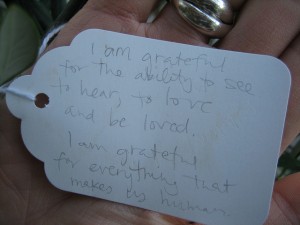“To speak gratitude is courteous and pleasant, to enact gratitude is generous and noble, but to live gratitude is to touch Heaven.”
–Johannes A. Gaertner
Gratitude is a part of the happiness holy grail: compared with those who aren’t practicing gratitude, scientists have found that people practicing gratitude:
- Are considerably more enthusiastic, interested, and determined;
- Feel 25% happier;
- Are more likely to be both kind and helpful to others.
Who doesn’t want these things?
What we’ve learned is that gratitude is a SKILL, like learning to speak German or swing a bat: it needs to be taught, and it needs to be practiced consciously and deliberately. If your family doesn’t have a regular gratitude routine, this is the week to start it.
Practicing gratitude can be blissfully simple: just count the things in your life that you feel thankful for, and ask your kids to do the same.
But this can be easier said than done, especially since some people just aren’t that grateful, and they really don’t want to be poked and prodded to practice gratitude.
One Size Does NOT Fit All
Turns out that not all people benefit from some gratitude practices. Having adolescents simply keep lists of things that they are thankful for doesn’t always increase their happiness and well-being in the ways that we would expect, based on the adult gratitude research. Why?
Many young teens are at that stage in their development where they are grasping for independence. So doing something that reminds them of how dependent they are on others, as gratitude practices can, can threaten their perception that they’re independent beings, liberating themselves from mom and dad. For these teens, then, it’s important to find gratitude practices that elicit feelings of appreciation but that don’t make them feel totally beholden to those around them. Putting the focus on what they feel grateful for about themselves or their own accomplishments can both elicit gratitude and emphasize their self-reliance.
The key with routine gratitude practices is creativity, and attention to the fact that we are simply trying to elicit a positive emotion—feelings of appreciation—just like we might try to elicit a smile from a baby. This means not insisting kids feel grateful, and certainly not telling them what they should feel grateful for; instead, it’s about creating an environment and situation where the feelings can naturally arise.
Here are some ideas for this holiday season:
- Start a tradition of writing “appreciations” on place cards. When hosting friends and family for a holiday meal, make large place cards for each person present, and then ask people to write things that they appreciate about one another on the inside of the place cards. Don’t ask people to write something about everyone present unless they want to – you don’t want to force the exercise. But do make sure that everyone has at least one thing written inside their place card, so that during the meal you can go around the table and share appreciations.
- Start a gratitude calendar. In the spirit of advent calendars, one of my daughter’s fabulous teachers, whom I appreciate VERY much, had the kids create a calendar with pockets that hold slips of paper on which they write the things they are thankful for. The things they write on those little pieces of paper—and then proudly place in the pockets of the calendar they made—are heart-warming and heart-felt. Kids wrote things on a half-dozen slips of paper or more and were thankful for a range of things. Moms figured in heavily, as did pets, friends, and favorite toys. (They were also funny: Henry, for example, is thankful for his “gift for doodling,” while Judge is thankful for his “good looks and style.”)
- Keep a family “gratitude list” or collection of things family members feel thankful for. Post a huge sheet of paper on your fridge and ask everyone to contribute to it when the spirit moves them. Anything can go on the list, no matter how large or small—people, places, toys, events, nature. Variations on this theme are endless. This year we are going to post the holiday card photos we receive from friends and family; under each card we’ll list the qualities those people possess that make us feel grateful for them.
How does your family practice gratitude? What has worked and what hasn’t?
Selected references:
Bronson, Po, and Ashley Merryman. Nurtureshock: New Thinking About Children. New York: Twelve, 2009.
Emmons, Robert A. “Pay It Forward.” Greater Good, 2007.
Emmons, Robert A., and Michael E. McCullough. The Psychology of Gratitude. New York: Oxford University Press, 2004.
Froh, Jeffrey, David Miller, and Stephanie Snyder. “Gratitude in Children and Adolescents: Development, Assessment, and School-Based Intervention.” School Psychology Forum: Research in Practice 2, no. 1 (2007): 1-13.
Froh, Jeffrey, William Sefnick, and Robert Emmons. “Counting Blessings in Early Adolescents: An Experimental Study of Gratitude and Subjective Well-Being.” Journal of School Psychology 46, no. 2 (2008): 213-33.
Seligman, Martin E.P., Tracy A. Steen, Nansook Park, and Christopher Peterson. “Positive Psychology Progress: Empirical Validation of Interventions.” American Psychologist 60, no. 5 (2005): 410-21.
Image courtesy of eekim

